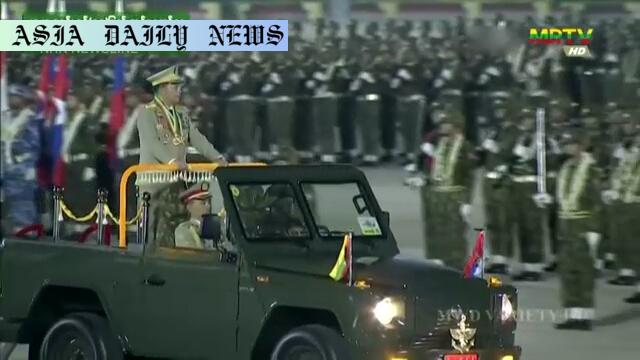Myanmar junta showcases annual Armed Forces Day parade overshadowed by ongoing fierce conflict and humanitarian crisis.
Myanmar’s military staged a grand Armed Forces Day parade in Naypyitaw.
International representatives, including Russia and China, attended.
Over 6,400 civilian deaths have resulted from ongoing conflict.
More than 3 million individuals have been displaced due to the crisis.

Myanmar Junta’s Military Display Amid Escalating Conflict
The Myanmar military government, often referred to as the junta, recently held a large-scale Armed Forces Day parade in the capital Naypyitaw. Characterized by a grand show of power, the event featured thousands of soldiers, tanks, heavy artillery, and advanced weaponry. Representatives from countries such as Russia and China, who have strong ties with Myanmar, were also present at the ceremony. The occasion symbolized the junta’s attempt to project dominance following years of internal strife and international condemnation.
However, this military extravaganza occurs against the backdrop of a nation torn apart. Since the junta’s seizure of power in a 2021 coup, the country has descended into a prolonged and brutal conflict involving the military regime, pro-democracy forces, and ethnic minority militias. A notable dynamic of this conflict is that it has not been confined to isolated incidents but has enveloped the country’s borders, especially in the eastern and western regions where the junta reportedly continues to lose ground.
The Dire Humanitarian Toll of Conflict
The violence and political instability have taken a severe toll on lives and livelihoods across Myanmar. As per reports by a local human rights group, more than 6,400 civilians and pro-democracy activists have lost their lives due to the conflict. The destruction has also led to one of Southeast Asia’s most critical humanitarian crises, with the United Nations estimating that over 3 million individuals have been displaced, forced to flee their homes to escape escalating violence. These figures are a stark indication of the scale of catastrophe that has enveloped the nation.
Additionally, essential services such as healthcare, education, and infrastructure have been severely disrupted in conflict-ridden areas. The junta’s inefficiency in addressing these issues has compounded the suffering of the civilian population. Despite these challenges, the escalation shows no signs of abating, with the junta bent on maintaining its grip on power at all costs.
Geopolitical Dynamics: The Roles of Russia and China
The attendance of Russia and China’s representatives at the Armed Forces Day parade illustrates Myanmar’s shifting geopolitical alignments. Both nations have long-held strategic interests in Myanmar, ranging from investments in its natural resources to maintaining influence in Southeast Asia. Russia has been a steady supplier of military equipment to Myanmar, while China has often provided diplomatic backing at the United Nations and other international forums. These alliances have drawn criticism from the global community, especially as they enable the junta to pursue its oppressive agenda unrestrained.
Yet, this relationship is not without complexity. While China has historically supported Myanmar’s government, it has also maintained ties with some ethnic minority groups in the border regions, which complicates its positioning in the ongoing internal conflict. Nevertheless, Russia and China’s visible involvement in ceremonies like Armed Forces Day may signal their willingness to support the junta, despite the international outcry against it.
Looking Ahead: A Nation in Crisis
The future of Myanmar remains uncertain as the struggle between military rule and pro-democracy forces intensifies. While the junta appears firm in its commitment to retain control, opposition forces have become increasingly resourceful, employing guerrilla tactics and drawing international attention to their plight. The question remains whether the global community will exert enough pressure—both economically and politically—to bring stability to the country.
Despite international sanctions and widespread condemnation, the junta’s resilience underscores the challenges in restoring peace. Yet, the resilience of the civilian population and ethnic minority groups in continuing their fight for democracy offers a glimmer of hope in an otherwise grim scenario. Resolving the crisis will undoubtedly require a multi-faceted approach involving international diplomacy, humanitarian assistance, and local reforms to address the grievances of Myanmar’s diverse population.
Commentary
The Complex Showcase of Power and Injustice
The recent Armed Forces Day parade in Myanmar reveals the stark contrasts that define the nation’s current state—showcasing power while the country suffers deeply. On one hand, the junta’s elaborate display of military capability in Naypyitaw signifies its attempts to assert dominance. Yet, these gestures fail to mask the extent of internal conflict that continues to devastate lives across the region.
The Humanitarian Tragedy
The humanitarian toll in Myanmar is heart-wrenching. With over 6,400 civilian casualties and more than 3 million displaced individuals, the narrative is one of immense human suffering. The stories of displacement and death are not mere statistics but represent the broken lives of individuals caught in a conflict they did not choose. This tragedy is a painful reminder of the costs of authoritarian governance combined with international inertia.
Geopolitics and Ethical Responsibilities
Russia and China’s visible support of Myanmar’s military regime further complicates the issue. Their involvement raises questions about ethical responsibilities in international relations. While each country operates within its strategic interests, there is arguably a heavier burden to consider the moral costs of backing regimes involved in widespread human rights abuses. For Myanmar’s people, the presence of international allies for the junta likely deepens their struggles, as this support enables the military to sustain its oppressive campaign.
Hope Amidst Adversity
Despite the overwhelming challenges, hope persists in the resistance movements and pro-democracy groups fighting for a brighter future. Their courage amidst dire circumstances is inspiring and deserves global solidarity. One can only hope that international communities will strengthen their efforts towards resolving the crisis and that Myanmar will one day emerge as a unified, peaceful nation.


